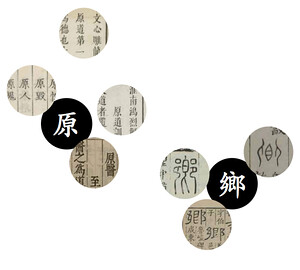Part of the launch events for the Wuzhen International Architecture Forum 2018, "On Home (or Ontology of Homespace)"
April 11–12, 2018
Rem Koolhaas to interview 17 intellectuals and practitioners at the Countryside Forum in Wuzhen as a part of Architecture Wuzhen 2018.
The Countryside Forum will be held in Wuzhen on April 11–12, 2018, during which Rem Koolhaas, the Pritzker Prize laureate, will interview 17 representatives from different parts and sectors of China at the Mu Xin Art Museum. Prof. Wen Tiejun, a well-known thinker specialized in rural issues, and Gen. Zhu Chenghu, a national defense strategy critic, will deliver two keynote speeches and discuss pressing issues such as the global crisis, rural revitalization, and related national strategies. The event, which is part of the launch series of events “On Home (or Ontology of Homespace),” the Wuzhen International Architecture Forum 2018, is organized by Cultural Wuzhen, the organizer of Wuzhen Theatre Festival and Wuzhen Art Biennale, and is curated by Mr. Jiang Jun, the founding editor of Urban China magazine and curator of the Chinese Pavilion at the Venice Architecture Biennale, 2014.
The Marathon is a typology of event invented by architect Rem Koolhaas and curator Hans Ulrich Obrist in 2006. At that time, Obrist was director of the Serpentine Gallery, and he commissioned Koolhaas to design the summer pavilion of the gallery. To activate this space, the pavilion became “a temporary space laboratory of knowledge” and “a reactor of thoughts,” where they hosted an activity that was a test of both mental and physical strength. Around 62 opinion leaders and practitioners from different backgrounds were invited to have conversations that lasted for 24 hours. In 2009, working with the curators Ou Ning and Jiang Jun, they introduced the Marathon to China, had a dialogue with 30 officials, entrepreneurs, scholars, artists, curators, architects, directors, photographers, writers, journalists, and social actors from Beijing, Shanghai, Guangzhou, Shenzhen, Hong Kong, and Taiwan. The event that lasted more than 8 hours. The theme of the marathon borrowed ideas from Koolhaas’ friend Mark Leonard, the executive chairman of the European Commission for foreign relations at the time. In 2008, he published a book titled What Does China Think?, in which he recorded his dialogue with different Chinese intellectuals. For this reason, the marathon was named The Chinese Thinking.
Based on this legacy, and in conjunction with the theme of “On Home (or Ontology of Homespace),” the first half of the event will be characterized as a “countryside Marathon,” in which Mr. Koolhaas, together with Stephan Petermann from OMA-AMO, will interview 17 intellectuals and practitioners on the Chinese Countryside. Interviewees also include Fang Yu (Vice President of the Shenzhen Branch of China Institute of Urban Planning and Design, principal of Belt & Road Research for the Ministry of Construction), Chen Xianghong (president and master planner of the Wuzhen Scenic Town), Peter Ho (Professor of Tsinghua University and LSE), Chen Danqing (an artist and curator of Mu Xin Art Museum), Ou Ning (curator, publisher, and practitioner of Bishan project), Mo Xi Zi Shi (Independent musician of Yi minority nationality), Lv Yao (journalist and writer on small peasants’ life and cooperation), as well as other artists and intellectuals who have been concentrated on countryside issues. The on-site dialogue will present China’s efforts in revitalizing the countryside from diverse perspectives.
The dialogue will be held in groups of two guests, each last 40 minutes, and the dialogue will take six hours without break. On April 12, (10am–12pm), the keynote speech by Mr. Wen Tiejun, a well-known rural construction scholar, and Mr. Zhu Chenghu, a national defense strategy expert will take place. The content of the Countryside Marathon and the keynote speeches will be recorded and published on e-flux Architecture, and in On(tology) of Home(town), the publication of the Wuzhen International Architecture Forum 2018, which will be released in conjunction with the other two events of the Wuzhen International Architecture Forum, known as “Use” and “Micromegas,” taking place at the end of the year. Mr. Koolhaas himself is also curating an exhibition entitled “Countryside” at the Guggenheim Museum in New York in 2019, in which the Countryside Marathon will be presented via videos and documents.
The three main themes of “On(tology) of Home(town),” “Use,” “Micromegas,” and “Countryside,” are respectively focusing on the three relationships of “home,” wich are object-being, collective-individual, and urban-rural. The core of the countryside issue is the urban-rural relationship. Aditional relationships being explored are those of worker-peasant, mind-mental, public-private, virtual-physical, as well as big (farmer)-small (peasant), first (developed)-later (developing), internal (endogeny)-external (exogenous), etc. With the new issues of geography, ecology, economy, society, politics, culture, history, and space arising from these series’ of relationships and contradictions, these questions are particularly urgent in the context of China’s efforts in revitalizing its countryside with the whole nation system, including: how to see the evolution of urban-rural relationships during different historical development stages that had been under the influences of domestic and international forces? What are the contradictions and relations between rural modernization and urban modernization? How to realize a balanced urban-rural development under the restriction of the binary urban-rural systematic opposition? How to balance the modern legal system, credit system, and contract system with that of human relationships of traditional rural societies? Under the context of rural revitalization policy, what kind of cooperation models can be applied by governments, enterprises, social institutions, and individuals at all levels, to achieve complementary roles with each other and best optimize the mechanism? How can the technologies of the internet and the “internet of things” play a role in solving the contradiction of urban-rural geographical constraints and resource allocation? How to form the commonness and individuality of different rural construction models? Does the non-replicable rural construction model make sense? What are the synergies and complementarities between rural revitalization and national strategies such as One Belt One Road, Xiong’an New District, and new township development?


